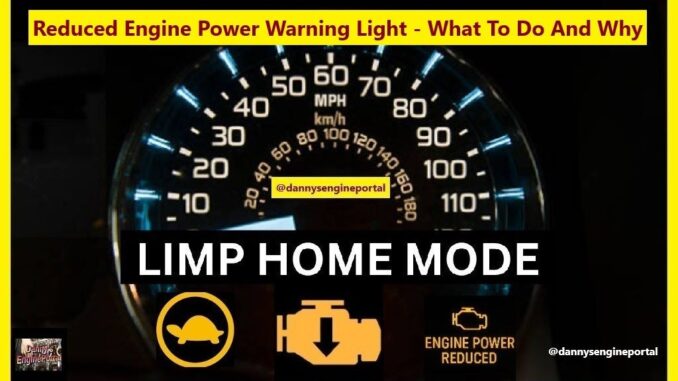
Reduced Engine Power, can have many different names. All depending on the year, make and model of your vehicle.
So, whether its, reduced engine power, limp mode, fail safe mode or limp home mode, they all mean the same thing.
But, reduced engine power, is the most common name, for late model vehicles.
So, the “reduced engine power” warning light on your dash, means that your vehicle’s performance has been reduced. Above all, to avoid damaging your engine.
What Can Make The Reduced Engine Power Warning Light Come On
Your vehicle can have a wide array of control modules that monitor values, from different sensors and actuators. So, as long as these values are what they would normally expect, then it would perform normally.
However, if the control modules all of a sudden receives, unbalanced signals, from one of the sensors. And, is out of the normal range. Then, the computer is programmed, to take some type of action.
So, depending on how far out of range this signal is, will decide what action will be taken. It may turn on something as simple as, a (CEL). And, in some cases, may save (DTC)s, which will indicate where the fault occurred.
Consequently, anything that upsets the balance, could cause a fault, and make any number of your warning lights come on. But, when the computer detects a fault, that is too far out of range, it will trigger this secondary mode.
As A Result, You May See Any One Of The Following:
- Reduced engine power mode
- Limp mode
- Fail safe mode
- Limp home mode
Just like when your home computer, when it goes into safe mode limiting functions that may cause further damage. When your vehicle goes into this mode, it operates with limited functionality and speed. So, this mode is intended to help the driver, get to a service shop safely.
For Instance, When The System Detects A Serious Problem With:
- Sensors
- Circuits
- Engine controls
- Transmission components
- Emission controls
- Brake controls
The First Three Things You Need To Check
Because, any one or combination, can cause, reduced engine power.
1, Faulty Ground Connections ( Very Common )
Faulty engine grounds, are sometimes to blame, for many apparently faulty parts or wires. So, one of the first checks you want to make, is the condition of engine grounds, including battery connections.
A faulty ground connection will cause, voltage and current to drop, leading to all kinds of driveability issues. So, check the engine grounds in your vehicle, with the use of a digital multimeter. This will make it easier, to detect loose, corroded or damaged connections. Consequently, affecting sensors, actuators or system circuits.
2, Diagnostic Trouble Codes (DTC)s
So, the first thing to check, is the (DTC)s. You can use a scan tool to download trouble codes, stored in the (ECM) of your vehicle.
Most of the time, these codes will steer you in the right direction, to see where the faults are.
3, Check For Technical Service Bulletins (TSB)s And Software Updates For, Reduced Engine Power
Actually, there are more issues than you think on this subject. Sometimes people jump into a repair, without reading all of the appropriate service information. So, one way to stay informed is, through the use of Technical Service Bulletins (TSB)s. Furthermore, a (TSB) provides information on, potential vehicle related issues.
Hence, a (TSB) is a communication, to update automaker publications, describe parts updates, inform of potential defects or failures. And, can also relay any enhanced or new service procedures. A (TSB) is not a recall, but rather an informative document, alerting the public to a potential problem.
Common Causes, For A Reduced Engine Power Warning Include:
- A loose wire, harness, or clamp
- (O2) sensors are failing
- (TPS) sensor is faulty
- A throttle body issue
- (MAF) sensor is faulty
- The (ECU) is faulty
- Fuel pump issues
- A clogged catalytic converter
- Fault in the transmission
- (CKP) or (CMP) sensors
- Accelerator pedal position sensor
- Bad ground
After scanning your vehicle, it should be fairly easy, to pinpoint exactly where the issue is coming from.
In Summary: Reduced Engine Power
Many of the causes of reduced engine power, are issues that will need to be addressed, immediately. However, this should not be a cause for panic. Consequently, most of these issues, can be repaired with a little research and some basic know how.
Taking your vehicle to a mechanic, will cost a little more than making the repair yourself. But, the benefit of their advanced scan tools, will save you time and prevent any mistakes you might make.
So, just remember the basics. Is a wire loose? Did a vacuum line fall off ? Do not look for, a complicated solution, to a simple problem. Finally, it is common to have a problem in one area, that impacts three or four others.
Thank You!




